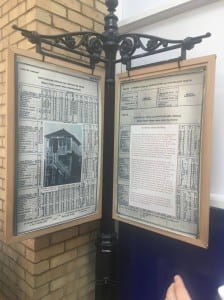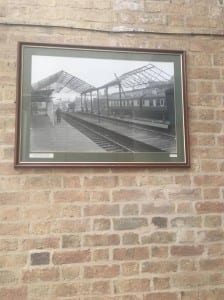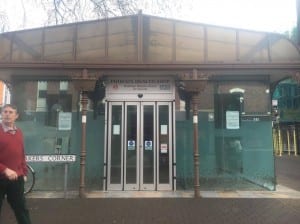|
Site (include brief rationale for choosing site) The majority of the high street. It is undecided yet but as a group we will either be scattered down the high street in a straight line from House of Fraser to just before the train lines, or in the shape of a cross around the area of the arches. We chose this site as represents the journey King Edward I and the body of his wife Eleanor took to London (From near the Cathedral to the train tracks, a direct link to London). Alternatively if we use the cross shape it is because it mimics the shape of the Eleanor Cross itself.
|
|
Critical and Contextual Engagement (justification of theorists/practitioners underpinning and influencing the performance so far) Slightly Cloudy Chance of Rain by Lee Miller and Jo Whalley: The idea of trading something for something else has influenced our piece, but rather than an object for an object like they did on the motorway, we want to trade flowers for love stories. Mark Auge: We are making a non-place (the high street) into a place by making it into a place where declarations of love occur. Deodry Heddon: Autobiographical – we are using our own and other people’s personal stories to create our piece. Joshua Soafer: Our piece is a piece of Live Art as it is created in the moment in front of the Audience, and only lasts for that moment, it is not a permanent fixture.
|
|
Description of Intended Performance (think about the relationship between performance, audience and performer/s) There are a few elements to our performance. Our audience are very much going to be incidental as opposed to invited. There will either be one, two or four of the group acting as town criers, shouting from different points in the city couple’s stories that we have gathered over the weeks leading up to the performance. If there is one they will be situated at the top of the high street by House of Fraser. If there are two the second will be situated at the bottom by the railroad tracks. If there are four the other two will be to the left and right of the high street, and the second person will be brought further up. With two people it will represent the final journey Queen Eleanor and Edward I made together from Lincoln to London, with four it will be in the shape of a cross to represent the Eleanor Crosses that Edward had built upon Eleanor’s death. In the middle of these town criers will be a simplified structure of an Eleanor Cross. It will be made of wood and one or two members of our group will be scratching into the wood names and dates of the couples who have given us their stories over the previous weeks. If there are not 4 town criers the remaining group members will be approaching people, focussing on couples in the high street asking them their stories, and they will then relay these back to the person/people at the sculpture so they can add them to the wooden cross. It is undecided how this information will be relayed. The relationship the audience has with the performance and performers will differ depending on how many town criers we choose to have. If we have one/two they will have a much more personal relationship as they will be interacting with us and seeing their stories become a part of our performance. Whereas if there are four it will be less personal/intimate but more immersive as they will be surrounded by the sound of these stories and each audience member may hear different parts of these stories more clearly than others, giving each audience member a different experience. |
|
Methods, Modes, Technologies and Experiments (what are the practical explorations that have led to the outcome as it stands in week seven)
Due to late group formation and having trouble creating ideas this week was the first week we actually tried anything practical. Although prior to this we have been gathering stories, which confirmed to us couples were willing to give personal information away, including photographs. This week we created a smaller version of the Eleanor Cross with paper on the floor of the high street and wrote down names of couples on it, and the date they began their relationship. We also included a bit of historical information about the original cross on a separate piece of paper just below it. People were immediately interested in what we were doing, and came over to read the names and information we had already written down, as well as asking us to explain what we were doing. Actually creating a structure showed to us that it will be enticing for audience members, and we believe it will be even more so when it is a 3D, larger structure and we are etching into the wood itself. We also practically tried shouting as town criers, and the public immediately quietened down when one, and four criers we shouting to hear what they had to say. Although using four town criers seems a little threatening especially in close proximity, so our next step is to try it again but at different distances and volumes. Although we were already collection stories online, we decided to try in the high street, for the short time we did it, it was successful, although as stated before we do not know how we will relay this information back to the structure, or if we’ll use it at all, considering the fact we may have 4 town criers, and may gain enough stories by asking for them through friends and on social networks.
|



